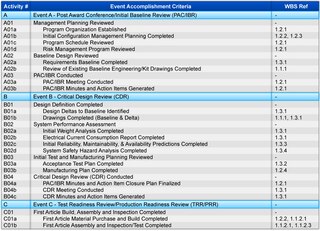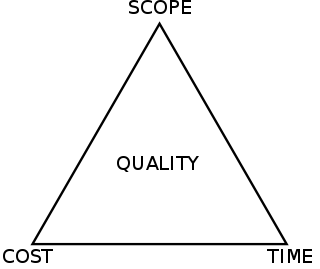Related Research Articles
Earned Value Management (EVM), earned value project management, or earned value performance management (EVPM) is a project management technique for measuring project performance and progress in an objective manner.
Project management is the process of leading the work of a team to achieve all project goals within the given constraints. This information is usually described in project documentation, created at the beginning of the development process. The primary constraints are scope, time, and budget. The secondary challenge is to optimize the allocation of necessary inputs and apply them to meet pre-defined objectives.

A work-breakdown structure (WBS) in project management and systems engineering is a deliverable-oriented breakdown of a project into smaller components. A work breakdown structure is a key project management element that organizes the team's work into manageable sections. The Project Management Body of Knowledge defines the work-breakdown structure as a "hierarchical decomposition of the total scope of work to be carried out by the project team to accomplish the project objectives and create the required deliverables."
Project planning is part of project management, which relates to the use of schedules such as Gantt charts to plan and subsequently report progress within the project environment. Project planning can be done manually or by the use of project management software.
Critical chain project management (CCPM) is a method of planning and managing projects that emphasizes the resources required to execute project tasks. It was developed by Eliyahu M. Goldratt. It differs from more traditional methods that derive from critical path and PERT algorithms, which emphasize task order and rigid scheduling. A critical chain project network strives to keep resources levelled, and requires that they be flexible in start times.

The critical path method (CPM), or critical path analysis (CPA), is an algorithm for scheduling a set of project activities. A critical path is determined by identifying the longest stretch of dependent activities and measuring the time required to complete them from start to finish. It is commonly used in conjunction with the program evaluation and review technique (PERT).
Project management software (PMS) has the capacity to help plan, organize, and manage resource tools and develop resource estimates. Depending on the sophistication of the software, it can manage estimation and planning, scheduling, cost control and budget management, resource allocation, collaboration software, communication, decision-making, quality management, time management and documentation or administration systems. Numerous PC and browser-based project management software and contract management software products and services are available.

The program evaluation and review technique (PERT) is a statistical tool used in project management, which was designed to analyze and represent the tasks involved in completing a given project.

In systems engineering, information systems and software engineering, the systems development life cycle (SDLC), also referred to as the application development life cycle, is a process for planning, creating, testing, and deploying an information system. The SDLC concept applies to a range of hardware and software configurations, as a system can be composed of hardware only, software only, or a combination of both. There are usually six stages in this cycle: requirement analysis, design, development and testing, implementation, documentation, and evaluation.
A responsibility assignment matrix (RAM), also known as RACI matrix or linear responsibility chart (LRC), describes the participation by various roles in completing tasks or deliverables for a project or business process. RACI is an acronym derived from the four key responsibilities most typically used: responsible, accountable, consulted, and informed. It is used for clarifying and defining roles and responsibilities in cross-functional or departmental projects and processes. There are a number of alternatives to the RACI model.
A statement of work (SOW) is a document routinely employed in the field of project management. It is the narrative description of a project's work requirement. It defines project-specific activities, deliverables and timelines for a vendor providing services to the client. The SOW typically also includes detailed requirements and pricing, with standard regulatory and governance terms and conditions. It is often an important accompaniment to a master service agreement or request for proposal (RFP).
Project workforce management is the practice of combining the coordination of all logistic elements of a project through a single software application. This includes planning and tracking of schedules and mileposts, cost and revenue, resource allocation, as well as overall management of these project elements. Efficiency is improved by eliminating manual processes, like spreadsheet tracking to monitor project progress. It also allows for at-a-glance status updates and ideally integrates with existing legacy applications in order to unify ongoing projects, enterprise resource planning (ERP) and broader organizational goals. There are a lot of logistic elements in a project. Different team members are responsible for managing each element and often, the organisation may have a mechanism to manage some logistic areas as well.
A hammock activity is a schedule or project planning term for a grouping of tasks that "hang" between two end dates it is tied to.
In project management, accurate estimates are the basis of sound project planning. Many processes have been developed to aid engineers in making accurate estimates, such as

In the United States Department of Defense, the Integrated Master Plan (IMP) and the Integrated Master Schedule (IMS) are important program management tools that provide significant assistance in the planning and scheduling of work efforts in large and complex materiel acquisitions. The IMP is an event-driven plan that documents the significant accomplishments necessary to complete the work and ties each accomplishment to a key program event. The IMP is expanded to a time-based IMS to produce a networked and multi-layered schedule showing all detailed tasks required to accomplish the work effort contained in the IMP. The IMS flows directly from the IMP and supplements it with additional levels of detail——both then form the foundations to implement an Earned Value Management System.
A glossary of terms relating to project management and consulting.

The project management triangle is a model of the constraints of project management. While its origins are unclear, it has been used since at least the 1950s. It contends that:
- The quality of work is constrained by the project's budget, deadlines and scope (features).
- The project manager can trade between constraints.
- Changes in one constraint necessitate changes in others to compensate or quality will suffer.
The following outline is provided as an overview of and topical guide to project management:
A value breakdown structure (VBS) is a project management technique introduced by Stephen Devaux as part of the total project control (TPC) approach to project and program value analysis.
References
- ↑ A Brief History of Scheduling (PDF)
- ↑ Project Management Institute (2003). A Guide to The Project Management Body of Knowledge (3rd ed.). Project Management Institute. ISBN 1-930699-45-X.
- ↑ "Scheduling Guide for Program Managers" (PDF). AcqNotes.com. Defense Systems Management College Press. 2001. Retrieved 14 Nov 2017.
- ↑ "GAO Schedule Assessment Guide, Best Practices for Project Schedules". General Accounting Office. General Accounting Office. December 2015. Retrieved 3 Jun 2016.
- ↑ Stallman, Greene, Applied Software Project Management Archived 2013-06-24 at the Wayback Machine O'Reilly press, Nov 2005
- ↑ "Beginner's Guide to Project Scheduling". Genius Project. Retrieved 15 May 2017.
- ↑ Cutting, Thomas, Cultivating a Healthy Project Schedule, PM Hut (Last accessed 8 November 2009).
- ↑ "Guidelines for Successful Acquisition and Management of Software-Intensive Systems, 7.2.1 Activity Definition". USAF Software Technology Support Center. Archived from the original on 2012-12-30. Retrieved 15 Jan 2016.
- ↑ "Program Schedule Quality 101". 16 Oct 2014. Retrieved 24 May 2016.
- ↑ "DCMA-EA PAM 200.1 Program Analysis Pamphlet" (PDF). Oct 2012. Archived from the original (PDF) on 1 November 2015. Retrieved 24 May 2016.
- ↑ "Planning & Scheduling Excellence Guide (PASEG)" (PDF). National Defense Industrial Association (NDIA). Mar 2016. Retrieved 17 Nov 2017.